Modulation of histone deposition by the karyopherin kap114
- PMID: 15713633
- PMCID: PMC549354
- DOI: 10.1128/MCB.25.5.1764-1778.2005
Modulation of histone deposition by the karyopherin kap114
Abstract
The nuclear import of histones is a prerequisite for the downstream deposition of histones to form chromatin. However, the coordinate regulation of these processes remains poorly understood. Here we demonstrate that Kap114p, the primary karyopherin/importin responsible for the nuclear import of histones H2A and H2B, modulates the deposition of histones H2A and H2B by the histone chaperone Nap1p. We show that a complex comprising Kap114p, histones H2A and H2B, and Nap1p is present in the nucleus and that the presence of this complex is specifically promoted by Nap1p. This places Kap114p in a position to modulate Nap1p function, and we demonstrate by the use of two different assay systems that Kap114p inhibits Nap1p-mediated chromatin assembly. The inhibition of H2A and H2B deposition by Kap114p results in the concomitant inhibition of RCC1 loading onto chromatin. Biochemical evidence suggests that the mechanism by which Kap114p modulates histone deposition primarily involves direct histone binding, while the interaction between Kap114p and Nap1p plays a secondary role. Furthermore, we found that the inhibition of histone deposition by Kap114p is partially reversed by RanGTP. Our results indicate a novel mechanism by which cells can regulate histone deposition and establish a coordinate link between histone nuclear import and chromatin assembly.
Figures
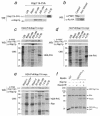

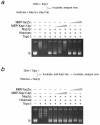
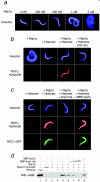
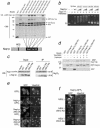

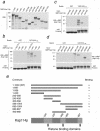




Similar articles
-
A role for nucleosome assembly protein 1 in the nuclear transport of histones H2A and H2B.EMBO J. 2002 Dec 2;21(23):6527-38. doi: 10.1093/emboj/cdf647. EMBO J. 2002. PMID: 12456659 Free PMC article.
-
Nuclear import of TFIIB is mediated by Kap114p, a karyopherin with multiple cargo-binding domains.Mol Biol Cell. 2005 Jul;16(7):3200-10. doi: 10.1091/mbc.e04-11-0990. Epub 2005 May 11. Mol Biol Cell. 2005. PMID: 15888545 Free PMC article.
-
Nuclear import of histone H2A and H2B is mediated by a network of karyopherins.J Cell Biol. 2001 Apr 16;153(2):251-62. doi: 10.1083/jcb.153.2.251. J Cell Biol. 2001. PMID: 11309407 Free PMC article.
-
Nuclear import of histones.Biochem Soc Trans. 2020 Dec 18;48(6):2753-2767. doi: 10.1042/BST20200572. Biochem Soc Trans. 2020. PMID: 33300986 Free PMC article. Review.
-
Chromatin assembly: biochemical identities and genetic redundancy.Curr Opin Genet Dev. 1999 Apr;9(2):185-90. doi: 10.1016/S0959-437X(99)80028-8. Curr Opin Genet Dev. 1999. PMID: 10322140 Review.
Cited by
-
Distinct roles for histone chaperones in the deposition of Htz1 in chromatin.Biosci Rep. 2014 Sep 19;34(5):e00139. doi: 10.1042/BSR20140092. Biosci Rep. 2014. PMID: 25338502 Free PMC article.
-
Transportin mediates nuclear entry of DNA in vertebrate systems.Traffic. 2009 Oct;10(10):1414-28. doi: 10.1111/j.1600-0854.2009.00968.x. Traffic. 2009. PMID: 19761539 Free PMC article.
-
Fuzzy Interactions Form and Shape the Histone Transport Complex.Mol Cell. 2019 Mar 21;73(6):1191-1203.e6. doi: 10.1016/j.molcel.2019.01.032. Epub 2019 Feb 26. Mol Cell. 2019. PMID: 30824373 Free PMC article.
-
Mechanism of RanGTP priming H2A-H2B release from Kap114 in an atypical RanGTP•Kap114•H2A-H2B complex.Proc Natl Acad Sci U S A. 2023 Jul 18;120(29):e2301199120. doi: 10.1073/pnas.2301199120. Epub 2023 Jul 14. Proc Natl Acad Sci U S A. 2023. PMID: 37450495 Free PMC article.
-
Dissection of CENP-C-directed centromere and kinetochore assembly.Mol Biol Cell. 2009 Oct;20(19):4246-55. doi: 10.1091/mbc.e09-05-0378. Epub 2009 Jul 29. Mol Biol Cell. 2009. PMID: 19641019 Free PMC article.
References
-
- Aitchison, J. D., G. Blobel, and M. P. Rout. 1996. Kap104p: a karyopherin involved in the nuclear transport of messenger RNA binding proteins. Science 274:624-627. - PubMed
-
- Belotserkovskaya, R., and D. Reinberg. 2004. Facts about FACT and transcript elongation through chromatin. Curr. Opin. Genet. Dev. 14:139-146. - PubMed
-
- Bilbao-Cortes, D., M. Hetzer, G. Langst, P. B. Becker, and I. W. Mattaj. 2002. Ran binds to chromatin by two distinct mechanisms. Curr. Biol. 12:1151-1156. - PubMed
-
- Casolari, J. M., C. R. Brown, S. Komili, J. West, H. Hieronymus, and P. A. Silver. 2004. Genome-wide localization of the nuclear transport machinery couples transcriptional status and nuclear organization. Cell 117:427-439. - PubMed
-
- Chang, L., S. S. Loranger, C. Mizzen, S. G. Ernst, C. D. Allis, and A. T. Annunziato. 1997. Histones in transit: cytosolic histone complexes and diacetylation of H4 during nucleosome assembly in human cells. Biochemistry 36:469-480. - PubMed
Publication types
MeSH terms
Substances
Grants and funding
LinkOut - more resources
Full Text Sources
Molecular Biology Databases
